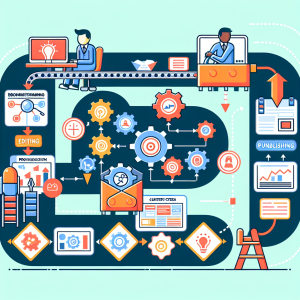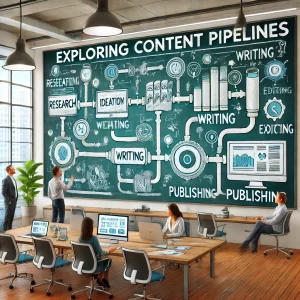
Introduction
In the realm of digital content creation, content pipelines and content workflows play a crucial role in ensuring that content is produced efficiently and meets the desired quality standards. As the demand for high-quality content continues to grow, understanding these concepts becomes increasingly relevant. This piece will provide an overview of content pipelines and workflows, their importance, and how they can enhance the content creation process.
Understanding Content Pipelines
Content pipelines refer to the series of steps and processes involved in creating content from initial concept to final publication. They are essentially the ‘assembly line’ of content production.
- Step-by-Step Explanation: The content pipeline typically begins with ideation, where content ideas are brainstormed. This is followed by content creation, editing, approval, and finally, publication.
- Specific Features: Some key features of content pipelines include task assignment, deadline tracking, and progress monitoring.
- Prerequisites: To effectively use a content pipeline, teams need a content management system (CMS) and collaboration tools.
Content pipelines help streamline the production process, ensuring that each piece of content undergoes the necessary checks and balances before reaching the audience.
Exploring Content Workflows
Content workflows, on the other hand, focus on the flow of tasks and approvals required to move a piece of content from one stage to another. They define the roles, responsibilities, and sequence of activities in content creation.
- Features & Functionalities: Workflows include stages such as drafting, editing, legal review, and marketing approval.
- Unique Aspects: A well-designed workflow adapts to different types of content and allows for parallel processing of tasks.
- Technology & Methodology: Workflow automation tools can be used to automate repetitive tasks, ensuring consistency and saving time.
Benefits
Implementing effective content pipelines and workflows offers numerous benefits:
- Efficiency: Streamlines content production, reducing delays and bottlenecks.
- Quality Control: Ensures every piece of content meets quality standards through systematic reviews and approvals.
- Accountability: Clarifies roles and responsibilities, making it easier to track progress and meet deadlines.
- Case Studies: Many organizations have successfully implemented these systems to vastly improve their content operations. Learn more about optimizing content creation.
Usage Tips
To make the most out of content pipelines and workflows, here are some practical tips:
- Best Practices: Regularly review and update your workflows to align with changing content strategies.
- Avoid Common Mistakes: Clearly define roles to prevent confusion and ensure smooth operation.
- Troubleshooting: Use analytics to identify bottlenecks and optimize your pipeline.
- Advanced Tips: Leverage AI and machine learning tools to automate and enhance workflows.
User Feedback
Users who have adopted structured content pipelines and workflows often report significant improvements:
- Positive Feedback: Many users highlight the enhanced organization and efficiency brought by these systems. For a detailed explanation, click here.
- Constructive Feedback: Some users suggest more flexibility in workflows to accommodate unique content types.
- User Stories: “Implementing an automated workflow reduced our content approval time by 50%,” notes a marketing manager.
Conclusion
In summary, content pipelines and workflows are essential for any organization aiming to produce high-quality content efficiently. By implementing these systems, you can streamline your content production, ensure quality control, and improve overall efficiency.
We encourage you to explore these concepts further and consider adopting them in your content strategy. For additional resources, articles, and tools to help you get started, check out our website.
Related Posts:
Efficient Content Management: Pipelines and Workflows Explained (97.53% match)
Optimizing Content Creation: Pipelines and Workflows (97.39% match)
Content Pipelines and Workflows Explained (97.34% match)





No comment yet, add your voice below!